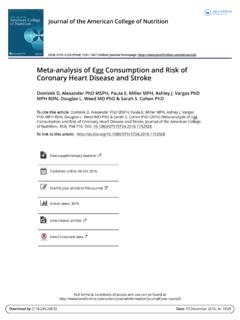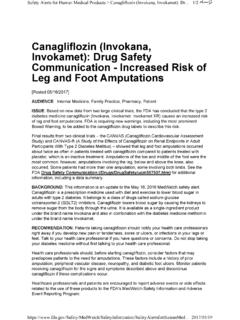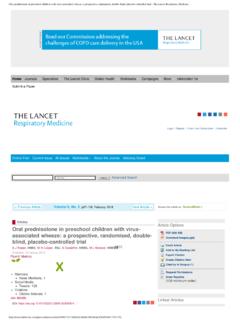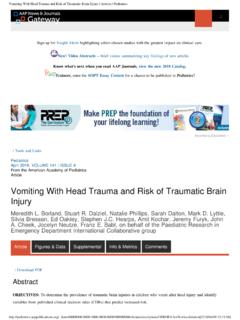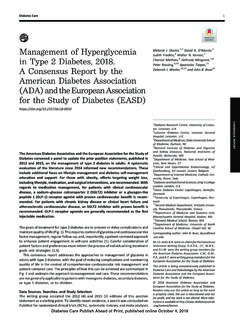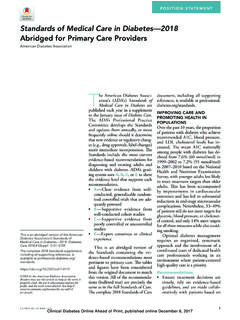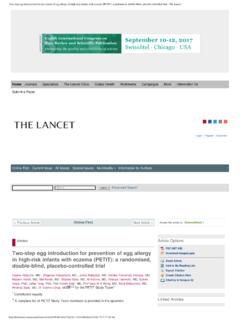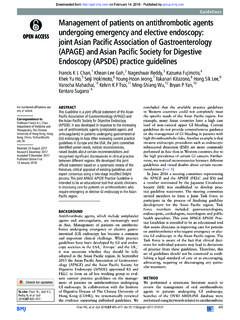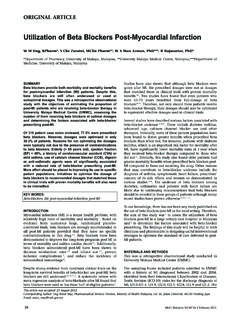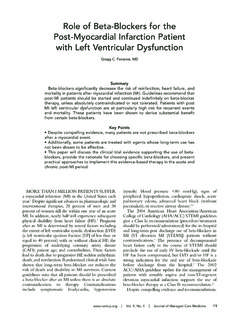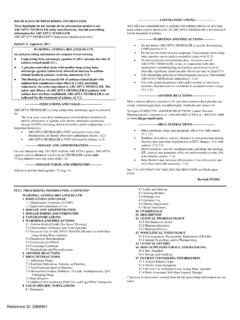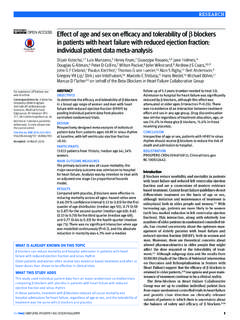Transcription of Decreased Mortality With Beta-Blockers in Patients With ...
1 JACC: HEART failure VOL. -, NO. -, 2016. 2016 BY THE AMERICAN COLLEGE OF CARDIOLOGY FOUNDATION ISSN 2213-1779/$ PUBLISHED BY ELSEVIER Decreased Mortality with Beta-Blockers in Patients with Heart failure and coexisting atrial fibrillation An AF-CHF Substudy Julia Cadrin-Tourigny, MD,a Azadeh Shohoudi, PHD,b Denis Roy, MD,a Mario Talajic, MD,a Ra k Tadros, MD, PHD,a Blandine Mond sert, MD,a Katia Dyrda, MD,a L na Rivard, MD,a Jason G. Andrade, MD,a Laurent Macle, MD,a Peter G. Guerra, MD,a Bernard Thibault, MD,a Marc Dubuc, MD,a Paul Khairy, MD, PHDa,b ABSTRACT.
2 OBJECTIVES The impact of Beta-Blockers on Mortality and hospitalizations was assessed in the largest randomized trial of Patients with both atrial brillation (AF) and heart failure with a reduced ejection fraction (HFrEF): the atrial fibrillation -Congestive Heart failure trial. BACKGROUND Although Beta-Blockers are the cornerstone of therapy for HFrEF, a recent patient-level meta-analysis cast doubt on their ef cacy in Patients with coexisting AF. METHODS From a total of 1,376 subjects randomized in the AF-CHF trial, those without Beta-Blockers at baseline were propensity matched to a maximum of 2 exposed Patients .
3 All absolute standardized differences after matching were #10%. Primary analyses respected the intention-to-treat principle. In on-treatment sensitivity analyses, beta-blocker status was modeled as a time-dependent covariate. RESULTS Baseline characteristics were comparable among the matched cohorts (mean age 70 11 years, 81% male, and mean left ventricular ejection fraction 27 6%). During a median follow-up of 37 months, Beta-Blockers were associated with signi cantly lower all-cause Mortality (hazard ratio [HR]: , 95% con dence interval [CI]: to ; p ) but not hospitalizations (HR: ; 95% CI: to ; p ).
4 Similar results were obtained in sensitivity analyses that modeled Beta-Blockers as a time-dependent variable (HR: for all-cause Mortality ; 95% CI: to ; p ; HR: for hospitalizations; 95% CI: to ; p ). There were no signi cant interactions between Beta-Blockers and patterns ( , persistent vs. paroxysmal) or burden of AF with respect to Mortality or hospitalizations. CONCLUSIONS In propensity-matched analyses, Beta-Blockers were associated with signi cantly lower Mortality but not hospitalizations in Patients with HFrEF and AF, irrespective of the pattern or burden of AF.
5 These results support current evidence-based recommendations for Beta-Blockers in Patients with HFrEF, whether or not they have associated AF. (J Am Coll Cardiol HF 2016;-:- -) 2016 by the American College of Cardiology Foundation. O ver the past few decades, several large randomized clinical trials have consistently demonstrated that Beta-Blockers decrease hospitalizations and improve survival in Patients ejection fraction (HFrEF). As such, Beta-Blockers have become a staple in the management of HFrEF.
6 And are strongly recommended (Class I, Level of Evi- dence: A) by North American (1,2) and European (3). with heart failure and a reduced left ventricular management guidelines. More recently, the Heart From the aMontreal Heart Institute, Universit de Montr al, Montreal, Quebec, Canada; and the bMontreal Health Innovations Coordinating Center, Universit de Montr al, Montreal, Quebec, Canada. The AF-CHF trial was funded by the Canadian Institutes of Health Research (MCT-41552). Dr. Macle has received lecture fees from Bayer, BMS-P zer, Boehringer-Ingelheim, Servier, Biosense-Webster, and St.
7 Jude Medical, and research grants from Biosense-Webster, St. Jude Medical, and Boehringer-Ingelheim. All other authors have reported that they have no relationships relevant to the contents of this paper to disclose. Manuscript received September 29, 2016; revised manuscript received October 25, 2016, accepted October 25, 2016. 2 Cadrin-Tourigny et al. JACC: HEART failure VOL. -, NO. -, 2016. Beta-Blockers for Heart failure with AF - 2016:- - ABBREVIATIONS failure Collaborative Group called into ques- in AF was previously detailed (7).
8 In brief, AF burden AND ACRONYMS tion the role of Beta-Blockers in Patients with was quanti ed by dividing time intervals between HFrEF and concomitant atrial brillation visits into quartiles. Sinus rhythm or AF was ACE = angiotensin-converting enzyme (AF). In a patient-level meta-analysis of 10 assigned to each time point for every patient on the randomized clinical trials that compared basis of electrocardiographic documentation and AF = atrial brillation Beta-Blockers with placebo, Beta-Blockers presence or absence of AF recurrences between visits.
9 ARB = angiotensin receptor blocker were not associated with a Mortality reduc- For each patient, the proportion of time spent in AF. CI = con dence interval tion in the subgroup of 3,063 Patients with was calculated by dividing the total time in AF by AF (4). Clinical implications of these provoc- follow-up duration. For the purposes of this analysis, HFrEF = heart failure with a reduced ejection fraction ative ndings are substantial, considering Patients were classi ed into 2 groups based on HR = hazard ratio that AF and HFrEF frequently coexist, with whether the proportion of time they spent in AF was LVEF = left ventricular ejection up to 50% of Patients with heart failure equal or superior ( , high AF burden ) or inferior fraction developing AF over the course of their dis- ( , low AF burden )
10 To the overall median value for NYHA = New York Heart ease. However, subgroup analyses based on proportion of time spent in AF. Association AF were not pre-speci ed in the studies Beta-Blockers . Beta-Blockers ( , metoprolol, included in the meta-analysis. Misclassi cation errors carvedilol, or bisoprolol) were recommended for the may arise from relying on a single baseline electrocar- treatment of heart failure along with angiotensin- diogram to establish the diagnosis of AF because it is converting enzyme (ACE) inhibitors/angiotensin re- an insensitive screening tool for nonpermanent AF ceptor blockers (ARBs), aldosterone antagonists in (5).
